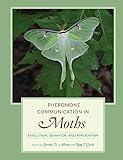Pheromone communication in moths: evolution, behavior, and application / edited by Jeremy D. Allison, Ring T. Cardé
Allison, Jeremy D [editor] | Cardé, Ring T [editor/a].
Tipo de material: Libro
impreso(a)
Editor: Oakland, California: University of California Press, 2016Descripción: vii, 401 páginas : fotografías, ilustraciones, gráficas ; 28 centímetros.ISBN: 0520278569; 9780520278561.Tema(s): Polillas
Libro
impreso(a)
Editor: Oakland, California: University of California Press, 2016Descripción: vii, 401 páginas : fotografías, ilustraciones, gráficas ; 28 centímetros.ISBN: 0520278569; 9780520278561.Tema(s): Polillas| Tipo de ítem | Biblioteca actual | Colección | Signatura | Estado | Fecha de vencimiento | Código de barras |
|---|---|---|---|---|---|---|
| Libros |
Biblioteca Tapachula
Texto colocado en la configuración de la biblioteca Tapachula |
Acervo General | 595.781 P4 | Disponible | ECO020013589 |
Incluye bibliografía
List of Contributors. Part One.. 1 Reminiscence of the Early Days.. 2 Pheromones: Reproductive lsolation and Evolution in Moths.. 3 Variation in Moth Pheromones: Causes and Consequences.. 4 Evolutionary Patterns of Pheromone Diversity in Lepidoptera.. 5 Sexual Selection.. 6 Genetic Control of Moth Sex Pheromone Signal and Response.. 7 Contextual Modulation of Moth Pheromone Perception by Plant Odors.. 8 Toward a Quantitative Paradigm for Sex Pheromone Production in Moths.. 9 Molecular Biology of Reception.. 10 Moth Sex Pheromone Olfaction: Flux and Flexibility in the Coordinated Confluences of Visual and Olfactory Pathways.. 11 Moth Navigation along Pheromone Plumes.. 12 Male Pheromones in Moths: Reproductive Isolation, Sexy Sons, and Good Genes.. Part Two.. 13 Small Ermine Moths: Role of Pheromones in Reproductive lsolation and Speciation.. 14 Possible Reproductive Character Displacement in Saturniid Moths in the Genus Hemileuca.. 15 The European Corn Borer Ostrinia nubilalis: Exotic Pest and Model System to Study Pheromone Evolution and Speciation.. 16 Divergence of the Sex Pheromone Systems in "Oriental" Ostrinia species.. 17 Utetheisa ornatrix (Erebidae, Arctiinae: A Case Study of Sexual Selection.. 18 Pheromone Communication, Behavior, and Ecology in the North American Choristoneura Genus.. 19 The Endemic New Zealand Genera Ctenopseustis and Planotortrix: A Down-Under Story of Leafroller Moth Sex Pheromone Evolution and Speciation.. 20 Evolution of Reproductive lsolation of Spodoptera Frugiperda.. 21 Pheromones of Heliothine Moths.. Part Three.. 22 Monitoring for Surveillance and Management.. 23 Pheromones as Management Tools: Mass Trapping and Lure-and-Kill.. 24 Mating Disruption of Moth Pests in lntegrated Pest Management: A Mechanistic Approach.. Index
Common among moths is a mate-finding system in which females emit a pheromone that induces males to fly upwind along the pheromone plume. Since the chemical pheromone of the domesticated silk moth was identified in 1959, a steady increase in the number of moth species whose pheromone attractants have been identified now results in a rich base for review and synthesis. Pheromone Communication in Moths summarizes moth pheromone biology, covering the chemical structures used by the various lineages, signal production and perception, the genetic control of moth pheromone traits, interactions of pheromones with host-plant volatiles, pheromone dispersal and orientation, male pheromones and courtship, and the evolutionary forces that have likely shaped pheromone signals and their role in sexual selection. Also included are chapters on practical applications in the control and monitoring of pest species as well as case studies that address pheromone systems in a number of species and groups of closely allied species. Pheromone Communication in Moths is an invaluable resource for entomologists, chemical ecologists, pest-management scientists, and professionals who study pheromone communication and pest management. eng
